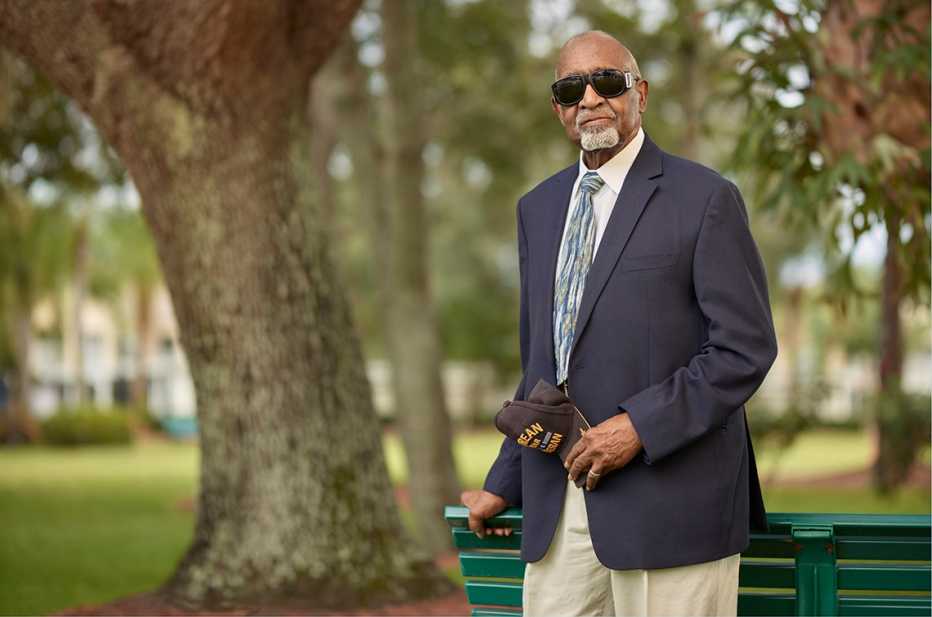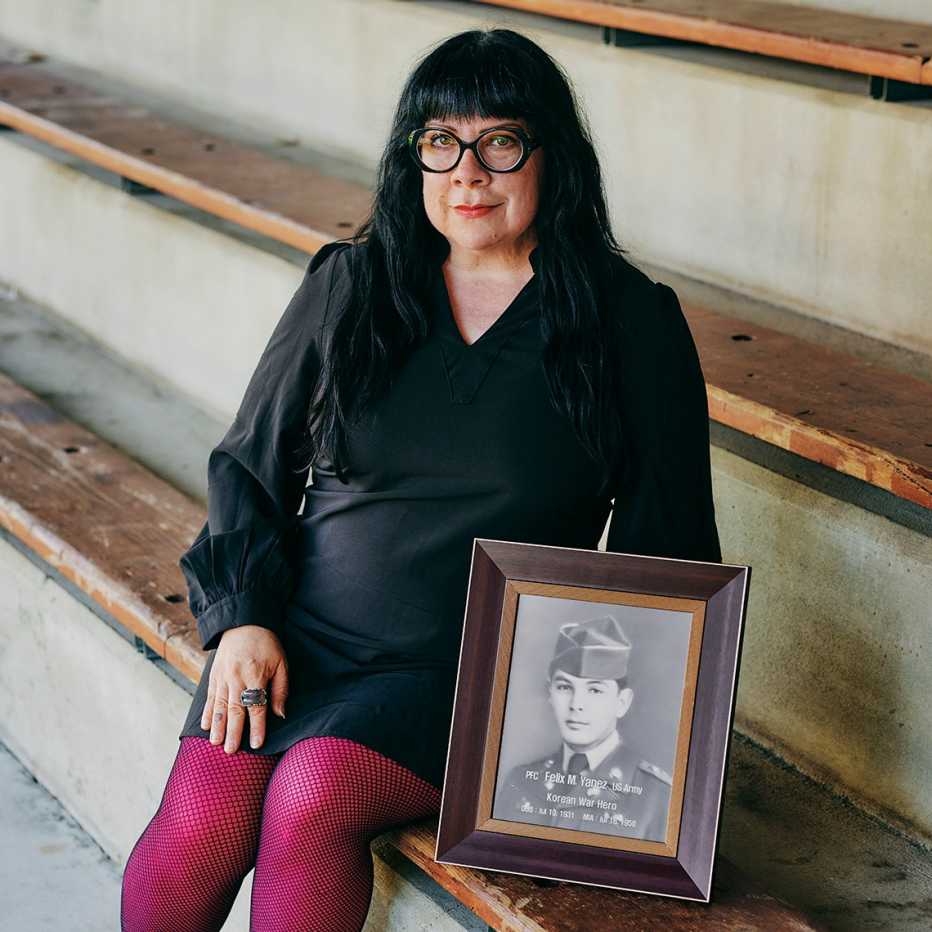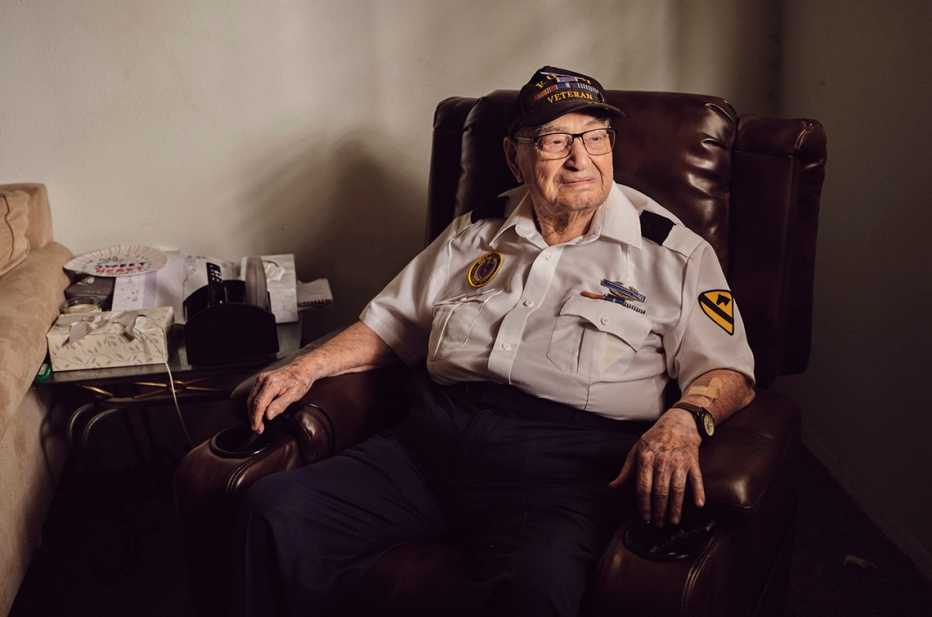I was just a young fellow, inducted into the Army in February of 1951 at Fort Ord, California. I had never heard of Korea. I was assigned to F Company, 23rd Regiment, 2nd Infantry Division. My unit was located at a place called the Punch Bowl [the Haean Basin in the Gangwon province of South Korea]. My good buddy, J.C. Coffey, was just 18. He’d lied about his age and joined the Army at 16. We fought together in the Battle of Bloody Ridge and, from there, we went to Heartbreak Ridge on Sept. 13, 1951. We lived in foxholes on C-rations.
You’d get a box every day with three cans of food, a box of chocolate, hardtack crackers and a pack of Lucky Strike cigarettes. Often we’d be up all night for days. Every now and then, you’d get pulled off the front line, and you’d get to go back and get a hot shower and new fatigues. That hot shower? Oh, boy. Let me tell you. Believe it or not, they sprayed our hair with DDT to kill the lice.
At Heartbreak Ridge, North Korea had the advantage. They were occupying the ridge and looking down, and we were trying to take it. A North Korean tank came around a corner and fired three rounds on us. These shots wiped out my squad, and I was the only survivor. My buddy J.C. Coffey was killed. So was another buddy, named Zalesky. I was evacuated, sent to Japan to a hospital for a month, and when I was ready, I was sent back to my unit.
The worst day was Christmas, 1951. It’s very cold in Korea. Of course, you couldn’t light fires because you would give your position away. We had jackets, but we weren’t equipped for that cold weather. There were a lot of people getting frostbite. My platoon went out to give support because our guys were trying to retrieve a broken tank. We got out there and we started to get all this mortar fire coming at us. I was running, and I tripped and fell down. Finally I got into this bunker. There was a little tiny teacup upside down. I figured it was a booby trap, as I saw a little wire coming off the handle. So I shot this cup, and the whole bunker blew up. But the good Lord was watching over me. It was snowing pretty heavily, and we were worried that we might be cut off from our lines. But, fortunately, we made it back that night. And they had a hot meal waiting for us. That was Christmas night, 1951.
I came back in June of 1952. I felt I should call my buddy J.C. Coffey’s mother, since I was the last one with him. I gave her a call and she — oh, my gosh. That was tough. She had me crying on the phone. She told me how she had begged him not to go. She said, “He was my only son. He was only 16 when he left.” It took a year for me to get back to normal. I accepted it, and then I did OK. I went back to my family business, working on tuna vessels. I eventually became a captain on some of those larger tuna boats. It’s been 70 years since the armistice. Not a lot of media have spoken about it, to mark that occasion. That’s why they call it the Forgotten War, I guess. Let me tell you, it will never be forgotten for us soldiers and our families.
Hal Simlak at home in Las Vegas on September 10, 2023.
Michael Friberg
An international effort
Harold “Hal” Simlak, 95, Las Vegas
- Corporal, U.S. Army, served in Korea from April to December 1951
- A retired Ford Motor Co. executive
I grew up in the Detroit area. I got my call to go in the Army when the Korean War went down. I took basic training at Fort Ord in California, which doesn’t exist anymore. From there we went overseas. Yokohama was the landing port in Japan, and from there, to Pusan in Korea. I ended up with the 1st Cavalry Division, 5th Regiment, Company I. We knew we were there as an agreement to protect this country. At that time, communists were very strong. Poland, Czechoslovakia, Romania — they were all communist then. The communists had taken over China. Naturally, if they took Korea, they would take Japan next, Australia after that. No doubt about that. So we understood that we had a job we had to do.
We lived in foxholes. Everybody was on alert, all the time. When they sent in mortars, those mortars would explode into 5,000 little pieces. When you heard one coming in — you could hear them — you would dive into one of the holes. We naturally had a certain amount of fear, that any of us could go at any time. Of course, you said, “I’m not afraid.” We were. We had some guys, I hate to mention this, who cracked up. I saw several of them. They were calling for their mother. When a guy is in combat and he’s yelling for his mother, that’s fear. Everybody had a weapon. A weapon was like a third arm. I had a carbine that I carried with me. I slept with it. I think everybody did. Naturally, if a guy got killed in your outfit, you didn’t like it. We didn’t feel sorry. We felt bitterness toward the enemy. In my company, Company I, we had two brothers who were twins. One of them got killed, and they immediately pulled the other out of action, and they sent him home. We were all kind of shocked about that when we learned.
It makes you appreciate your life. You needed a certain amount of luck. I was hit by shrapnel and got the Purple Heart.” A unique thing about the Korean War was that we were there as part of the United Nations. We knew that right after World War II, that all these countries were organizing the United Nations. Exactly what that meant, we did not know until the war came along. Then it was more understood that all these countries were supposed to be cooperating, in protecting the world. [The U.N. was founded in 1945, five years before the Korean War started.]
We had the Greeks attached to us. There were Belgian soldiers and soldiers from the Netherlands. The largest units next to us were the British. And the Canadians had a brigade of, like, 10,000 men. They were good soldiers, I’ll tell you that.
After the war, I came back and worked with a security company that made circuit breakers. Then I worked for Ford Motor Co. I have always felt proud of what we achieved in Korea. We understood why we were there. In Korea, in those days, there was no such thing as a factory. They were nice people. They worked with us, and they had a good army. We stopped communism from spreading. If you look at South Korea today, it’s nothing like it was then. There was nothing there then. Today, it has one of the largest economies in the world. A lot of people I talk to today do not know much about the Korean War. They are just learning now. And they are looking at this situation in Ukraine. Russia is trying to take over Ukraine, just like Russia tried to take over the Korean Peninsula. It is just like it was, when we were fighting in Korea, all these years later.
Sgt Paul Cunningham stands along the walk leading up to a "Never Forget Garden" built in commemoration of the centennial of the Tomb of the Unknown Soldier in the Woodcrest Villas retirement community on September 12, 2023, in Lancaster Pennsylvania.
Benjamin C. Tankersley
Walking Korean soil years later
Paul H. Cunningham, 95, of Lancaster, Pennsylvania
- Staff sergeant, U.S. Air Force, served in Korea from September 1950 to February 1952
- A retired school administrator and curriculum director
I was born in the city of Lancaster. My father was in the Pennsylvania National Guard, and he had served in the Philippines and Siberia in 1919. In 1948, I graduated from John Piersol McCaskey High School. I thought I’d go into the military, and maybe by the end of my three years of service, I would know what I wanted to do. My dad found out about a program that, if I enlisted in the Air Force, I could apply for a tech school of my choice. I applied and got my first choice, to learn to be a radar repairman.
I was sent to Keesler Field in Biloxi, Mississippi, then to Shaw Air Force Base in South Carolina. We had just returned from a maneuver in North Carolina when, on June 25, 1950, the Korean War broke out. We were all hauled into the dayroom, and the squadron commander told us we were at war. He said, “President Truman has extended all your enlistments by one year.” We got word that we were going overseas. All signs pointed that we were going to Korea. And we did.
(From left) Mike Farrell, Loretta Swit and Alan Alda, star in the television series 'M*A*S*H.'
Silver Screen Collection/Getty Images
The Korean War Imagined on Film and Screen
An oft-forgotten fact about the Forgotten War: It unfolded at the same time that televisions were arriving in America’s homes. It was the first war to be visualized on TV, starting with an episode called “Christmas in Korea” on the Edward R. Murrow news show See It Now.
“This is Korea, this is the front,” Murrow says into the camera, sitting behind a wall of sandbags on Christmas Eve, 1952. “Just there, no man’s land begins. And on the ridges over there, the enemy positions can be clearly seen.”
“It was a riveting journalistic production,” says David Bianculli, a professor, author and television critic on NPR’s Fresh Air With Terry Gross. “It brought home the reality of life in a war zone as never before.”
There were Korean War movies, too. More than a dozen came out during the war’s three-year span, and more followed through the years. Standouts include The Manchurian Candidate (1962) and M*A*S*H (1970).
But it was the M*A*S*H TV series that illuminated the Korean War experience for generations of viewers. The show’s timing was important, as it began airing at the tail end of the Vietnam War. “M*A*S*H brought an anti-war sensibility to a war program,” Bianculli says. “You could not do that with the Vietnam War while it was going on, but everyone understood the parallels.” M*A*S*H saw a trailblazing female character in Army Maj. Margaret “Hot Lips” Houlihan. It was also one of the first shows to kill off a character unexpectedly — Lt. Col. Henry Blake (played by McLean Stevenson). “The idea of life and death really played a factor, even among the doctors in this war,” Bianculli says. The show ran for so long (1972 to 1983) because, as Bianculli notes, “it was real life intertwined with fiction. It lasted four times as long as the war itself, because it told the story so well.”
— A.J. Baime
On Sept. 20, 1950, we arrived at Pusan, and there we set up a radar station on the top of a hill. We moved to Osan, to Incheon, to Pyeongtaek and to Kimpo Air Base, west of Seoul, to operate and set up stations. Our mission was to maintain air surveillance over North and South Korea. Our radar tracked all aircraft, enemy and friendly, incoming and outgoing. We aimed for 24-hour coverage. We were given one hour a month for routine maintenance. So we were online virtually all the time. I was never in harm’s way. When we moved to Kimpo airfield, that was the closest I got to the front lines. But our radar performed a pretty important role. Our level of proficiency earned us both the U.S. and the Korean presidential unit citation.
I came back to my native Lancaster and became a history teacher. Later, I helped form a chapter of the Korean War Veterans Association. I guess I was a prime mover on it, because I became the first president, and in three years, we were the second largest of all the groups across the country. I was later elected president of the national Korean War Veterans Association. During my presidency, I had four invitations to visit Korea. I chose to decline because my presence here was more pressing. I did get to see other veterans go in my place. Before the pandemic, I chose not to run for reelection, and the invitations to Korea stopped during the pandemic. A year ago, they resumed, so I finally made the trip in September of last year as a guest of the South Korean government.
It was the first time I was back since I left Korea in 1952. I was accompanied by my younger son and a grandson. At one point, I said to my son, “You know, we’re in Seoul. We’re not too far from my last duty station.” He said, “Dad, I’ll get a car and a driver.” I pinpointed my last duty station on a Google map, and we went there. Kimpo Air Base is now Gimpo International Airport. In 1952, there was this barren hill where we set up our radar station. There was still a radar station there. Our driver spoke to the guard at the gate and he let us through. I went to the top of the hill and I got to walk the soil that I had walked over 70 years earlier. Back then, all we knew was that we were stopping communism in its tracks. That was a time when a red line meant something. A line drawn in the sand.
Editor's note: This article, originally published on Nov. 3, 2023, has been updated to reflect the passage of time.











































































More From AARP
How a Korean War Veteran's Hate Transformed Into Love
This 90-year-old veteran has returned to visit South Korea nine timesAn Exclamation Point on my Grandfather’s Service
An Honor Flight to Washington, D.C., was a capstone of this Korean War veteran’s life and cemented his legacyHow to Arrange an Honor Flight for a Veteran
A VIP visit to national memorials in Washington awaits